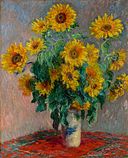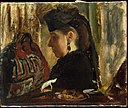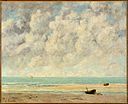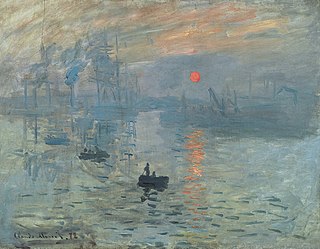
Impressionism was a 19th-century art movement characterized by relatively small, thin, yet visible brush strokes, open composition, emphasis on accurate depiction of light in its changing qualities, ordinary subject matter, unusual visual angles, and inclusion of movement as a crucial element of human perception and experience. Impressionism originated with a group of Paris-based artists whose independent exhibitions brought them to prominence during the 1870s and 1880s.

Mary Stevenson Cassatt was an American painter and printmaker. She was born in Allegheny, Pennsylvania, and lived much of her adult life in France, where she befriended Edgar Degas and exhibited with the Impressionists. Cassatt often created images of the social and private lives of women, with particular emphasis on the intimate bonds between mothers and children.

Edgar Degas was a French Impressionist artist famous for his pastel drawings and oil paintings.
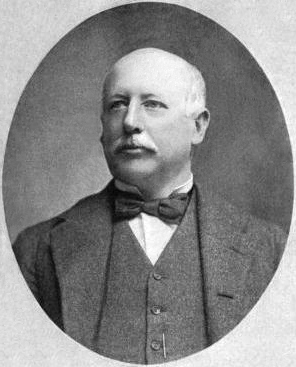
Henry Osborne Havemeyer was an American industrialist, entrepreneur and sugar refiner who founded and became president of the American Sugar Refining Company in 1891.

Shelburne Museum is a museum of art, design, and Americana located in Shelburne, Vermont, United States. Over 150,000 works are exhibited in 39 exhibition buildings, 25 of which are historic and were relocated to the museum grounds. It is located on 45 acres (18 ha) near Lake Champlain.
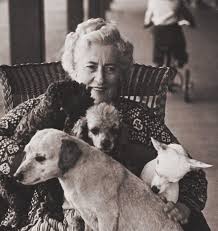
Electra Havemeyer Webb was a collector of American antiques and founder of the Shelburne Museum.

The Little Fourteen-Year-Old Dancer is a sculpture begun c. 1880 by Edgar Degas of a young student of the Paris Opera Ballet dance school, a Belgian named Marie van Goethem.
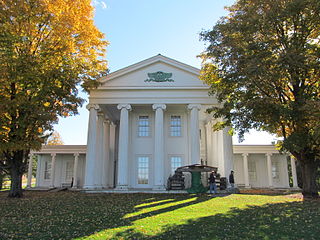
The Electra Havemeyer Webb Memorial Building is an exhibit building located at the Shelburne Museum in Shelburne, in the U.S. state of Vermont. It was built as a memorial to the museum's founder, Electra Havemeyer Webb, and her husband, James Watson Webb II. It is home to the museum's European Paintings Collection. The collection is shown in six period rooms relocated from Electra and J. Watson Webb's 1930s New York City apartment at 740 Park Avenue.

Mont Sainte-Victoire and the Viaduct of the Arc River Valley is an oil painting on canvas completed by the French artist Paul Cézanne between 1882 and 1885. It depicts Montagne Sainte-Victoire and the valley of the Arc River, with Cézanne's hometown of Aix-en-Provence in the background. Once owned by the art collectors and patrons Henry and Louisine Havemeyer, the painting was bequeathed to the Metropolitan Museum of Art in New York after the latter's death in 1929.

Gardner (Cassatt) Held by His Mother is a drypoint print dated circa 1889 by the American painter, printmaker, pastelist, and connoisseur Mary Cassatt. The example illustrated is in the collection of the Cooper-Hewitt Museum and is a gift of Samuel Putnam Avery.

The Boating Party is an oil painting by American artist Mary Cassatt created in 1893. It is also known under the titles La partie en bateau; La barque; Les canotiers; and En canot. Measuring nearly three by four feet, it is Cassatt’s largest and most ambitious painting. It has been in the Chester Dale Collection of the National Gallery of Art since 1963.

Young Mother Sewing aka Little Girl Leaning on her Mother's Knee is a 1900 painting by the American artist Mary Cassatt. It is in the collection of the Metropolitan Museum of Art.

Mother and Child (The Oval Mirror) is an oil-on-canvas painting by the American Impressionist artist Mary Cassatt. The painting depicts a mother and her child in front of a mirror. The painting provides a glimpse of the domestic life of a mother and her child, evoking religious iconography from the Italian Renaissance. However, portrayals of a mother and her child are common in Cassatt's work, so it is possible that this similarity is coincidental rather than intentional.
The Havemeyer family is a prominent New York family of German origin that owned significant sugar refining interests in the United States.

The Collector of Prints is an oil-on-canvas painting by the French Impressionist artist Edgar Degas. The painting, which was produced in 1866, depicts an unknown male subject sitting down, pausing while browsing through a portfolio of prints and meeting the viewer's gaze. This work, influenced by prominent artists and critics of the time such as Daumier, Manet, and Duranty, embodied Degas's interest in exploring complex backgrounds. As a result, the background behind the subject displays a varied compilation of photographs, cards, prints, fabrics, and other objects.

Boating is an oil-on-canvas painting by French artist Édouard Manet. The painting depicts a man and woman on a sailboat during the summertime. It was painted during in the summer of 1874, during which time Manet was staying on his family's property in Gennevilliers. Art historians have suggested that the woman may be Camille Monet, while the man has often been identified as Manet's brother-in-law Rodolphe Leenhoff.

The Matador Saluting is an oil-on-canvas painting produced by Édouard Manet between 1866 and 1867. Its precise date is unclear – Charles S. Moffett dates the first definite reference to the work to 1867, at an exhibition devoted to Manet's works at the pavillon de l'Alma.

Elizabeth "Elsie" Foster Cassatt Stewart was an American sportswoman and socialite.

Woman with a Sunflower is a 1905 oil painting by the American artist Mary Cassatt. It has been in the collection of the National Gallery of Art in Washington, DC since 1963.
Girl Arranging Her Hair is an 1886 painting by American artist Mary Cassatt. The painting currently is in the collection of the National Gallery of Art, in Washington, D.C. It was originally exhibited at the Eighth and last Impressionist exhibition, which opened on May 15, 1886.


























































